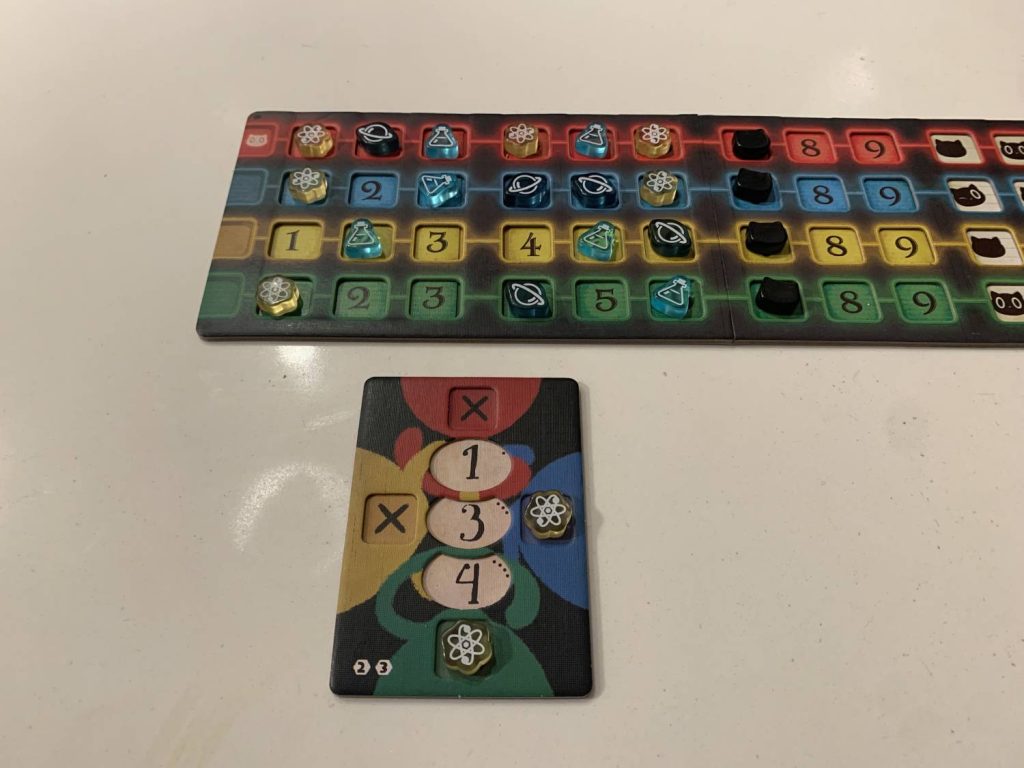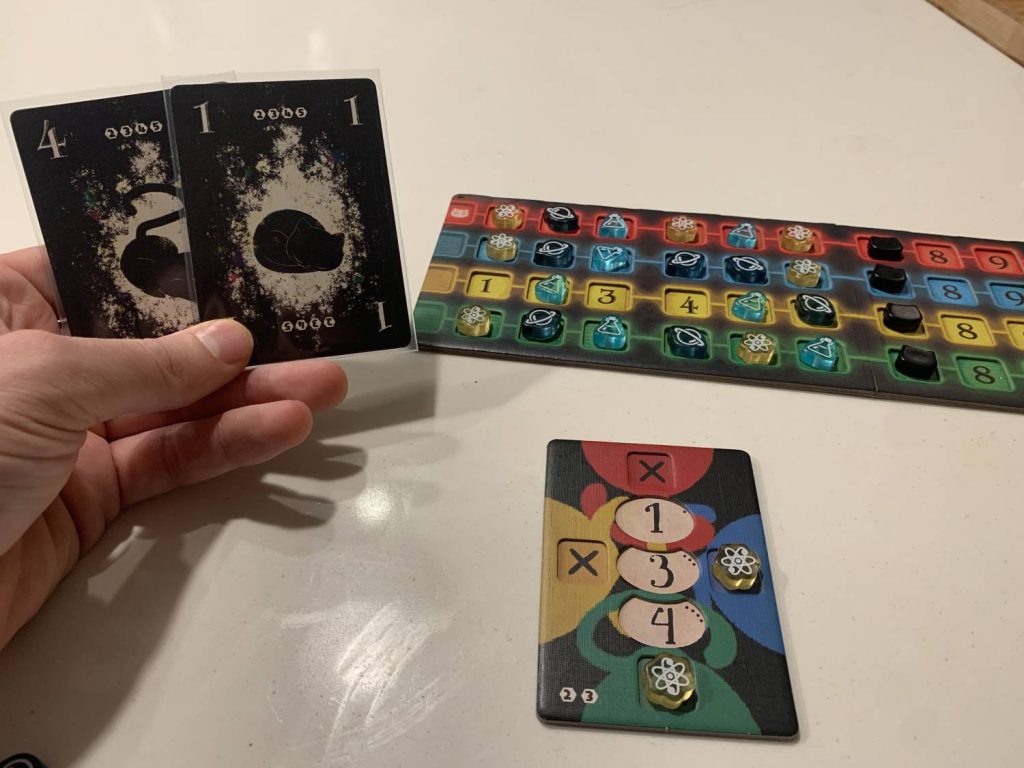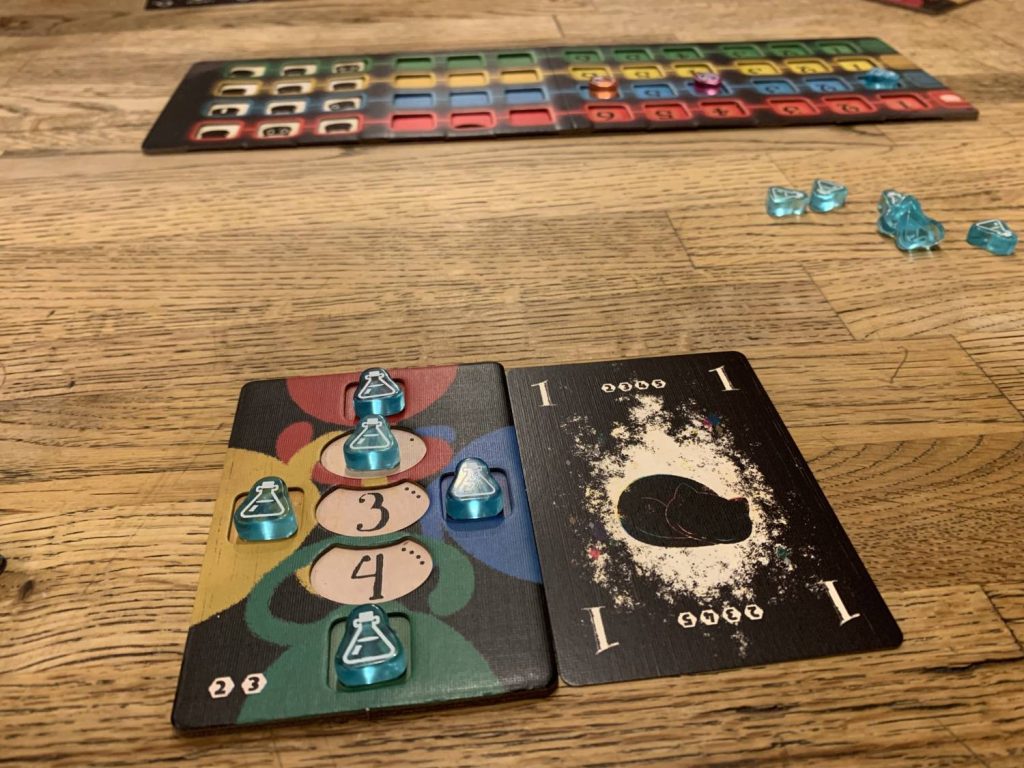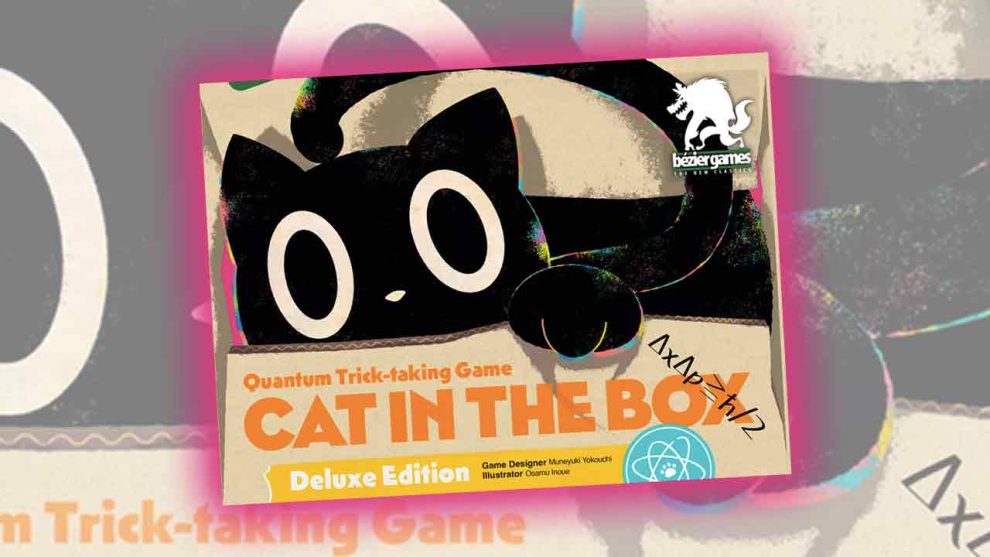Disclosure: Meeple Mountain received a free copy of this product in exchange for an honest, unbiased review. This review is not intended to be an endorsement.
Schrödinger’s Cat used to be fun to talk about at parties. You were once able to impress your friends by talking about that whacky cat and his flask of poison. The unwashed masses would be entertained for hours—hours, I swear—as you discussed the finer details of this particularly digestible paradox of quantum superposition.
That’s all gone now, of course. Schrödinger’s Cat has been memeified enough that everyone knows the basics. You smile, open your mouth, say “Do any of you know about Schrö–“ and everyone shuts you down. The hoary old chestnuts simply don’t cut it anymore. This has left people like me in a difficult position. Now how are we to entertain people with advanced physics?
Enter designer Muneyuki Yokouchi and publisher Bézier Games with the new deluxe edition of 2020’s Cat in the Box, a quantum trick-taking game that throws me a lifeline.
“Do any of you know about Schrödinger’s Cat?”
“Yes, Andrew, we all know about Schrödinger’s Cat.”
“But do you know about the card game adapted from the Schrödinger’s Cat source material?”
“Wait, the what?”
Oh yes. Oh, yes.
What We Talk About When We Talk About Trick-Taking
Cat in the Box is a brilliant design, but understanding and appreciating that brilliance relies on an understanding of trick-taking as a whole. We shouldn’t talk about Cat in the Box more without making sure you have a basic understanding of the genre. Feel free to skip this section if you already do.
You’ve probably played a trick-taking game at some point. Spades. Hearts. Whist. Contract Bridge. Oh Hell. Tarot for les francophiles. If you haven’t, the fundamental idea is pretty simple. I’ll walk you through a hand.
Jenn leads the trick, which means they play the first card. Let’s say Jenn plays the 5 of diamonds, which they chuck into the middle of the table with resignation.
All players have to follow, which means they have to play a card in the same suit as the lead if possible. Dinesh has the 3 and Queen of Diamonds. Since the goal of our imaginary trick-taking game is to win as many tricks as possible, Dinesh opts to play the Queen.
Simon sighs with resignation. He’s out of Diamonds, so he plays the 2 of Clubs. Since it’s not in the lead suit, it won’t do anything. This is a lost cause.
Bryan isn’t having any more luck, and puts in the 7 of Diamonds.
Dinesh takes the trick, since the Queen of Diamonds is the highest card played in the leading suit. Dinesh will lead the next trick, which would play out along similar lines.
There’s one last concept we have to cover: the trump suit. Many trick-taking games use a trump suit, which supersedes the leading suit in deciding who claims the trick. In this example, if Clubs were the trump suit, the trick would instead go to Simon.
Our key terms here are: Suit; Lead; Follow; Trump. If you’ve got a firm handle on all four of those, we can move on.
Whatever Suits You
Cat in the Box has no suits. Well, not initially. All of the cards are black. They carry the potential to be green, yellow, blue, or red until observed, which is to say until played. In the middle of the table, there’s a board depicting the numbers 1-9 in all four colors. You play cards from your hand to one of the four sides of your player board, declaring what color it is. “I observe the green 6,” for example. That suitless 6 is now green.
In fact, it’s the only green 6 in the game. You place a player token onto the green 6 slot of the central board. Having been observed, the green 6 is no longer available to other players.

This is, in a word, neat.
You watch your hand diminish before your eyes, the initial 1,048,576 or so different possible timelines for your own cards in a 4-player game collapsing into fewer and fewer concrete realities as cards are played and suits claimed. Your options don’t simply narrow as a round progresses, they fall off a cliff.
I Will Follow You
On its own, the suitlessness is a gimmick. A fun gimmick, but a gimmick. What makes Cat in the Box a brilliant design is how the quantum suit state interacts with following. Do you have to follow in Cat in the Box? Yes. Well. No. Maybe?
You can follow or not. It’s up to you. Not following comes with consequences, though. If the trick is led with a yellow card, you don’t have to play a yellow card. You are observing and declaring your own hand, after all. You could play a green, blue, or red card just as easily as a yellow. As soon as you say you don’t have a yellow, though, you can’t play yellow again for the rest of that round. You say you don’t have yellow, so you don’t. For those well versed in trick taking, Cat in the Box is a game during which you can choose to short suit yourself any time.

This is, in a word, neat.
Red, by the way, is always the trump suit, but you can’t lead with it until somebody has played red while following. That is an interesting way of neutering the advantage that comes with going first in a trick-taking game. Across my plays, I’ve come to realize that the greatest opportunity for control in the early game belongs to the second player, but it comes at a risk. You can only jump suit by cutting yourself out of a whole color for the rest of the round.
What, two of ‘em?
A round of Cat in the Box ends in one of two ways: either everyone plays down to their last card, or someone causes a paradox.
There are four slots for each number, one for each suit, but there are five cards of each number. If it comes to your turn and you cannot play a card, either because the four other cards in that number have been played, or because the only available slot is in a suit you declared yourself out of earlier, you cause a paradox.

At some point, unless everyone has been very lucky, somebody’s causing a paradox. You start the round by removing one card from your hand, and will end up playing all but one of the cards remaining. Paradoxes are something you can work to avoid, but they will happen. This increases the pressure as your hand reduces in possibility, as you see your escape window narrow until it potentially blinks out of existence.
This too is, in a word, Neat.
But Wait, There’s More
Scoring is a combination of two things, one of them straightforward: you score one point per trick that you take during a round, unless you cause a paradox. In that case, you lose one point per trick you’ve taken. This makes a certain amount of sense. If you’ve spent the whole round running the table, controlling and winning every trick, you should have been paying more attention to the options you had left.
The other avenue for scoring comes from that old trick-taking standby, bids. At the beginning of each round—there will be one round per player—everyone bids on how many tricks they think they’ll win. There are set options on the player boards, and you have to pick one.

At the end of the round, each player who accurately predicted their haul of tricks will get a bonus. That bonus is based on the largest contiguous area of their player tokens on the board.
Folks, it was secretly an area control game all along.
This is. In a word. Neat.
The Cat’s Out the Bag
Every time I play Cat in the Box, I learn something new. Certain rounds will be spent trying to win as many tricks as possible, blowing past your bid and making up for it in raw numbers. Others will be spent trying to secure your bid and then quietly building as large of a contiguous area on the board as you can. Sometimes you’ll look at your hand and know you can risk short-suiting yourself early on, your hand providing enough flexibility to do that.
Scoring is always relatively tight, and one great round can close the gap.
I have spent 1,500 words, the longest straight review of my Meeple Mountain career, talking about a small card game. I could probably keep talking about it, but I should eventually go outside. Go get a copy of Cat in the Box. Buy two, even. It’s cheap, you can afford it. This game is fun, it’s dramatic, it’s funny, it’s crunchy. It is, in a word, neat.
A Brief Note Pertaining to the Use of Combinatorics
The combinatorics for a given hand, given the possibility of a paradox, are a little squishy. I calculated the possible permutations of a starting hand in a 4-player game as 4^10, since there are four suit possibilities for each card, and you have ten cards. 5^10 may be more accurate, since a paradox outcome is still an outcome. The exact number will vary from hand to hand, since each time you get another card of the same number, its permutational potential is one lower than the previous. I also wasn’t sure how to incorporate the removal of a single card at the beginning of the round, which feels like it must introduce something new into the math.












Add Comment